
Bradypodion is one of six genera of chameleons within the "true" or "typical" chameleons. They are native to southern Africa, and are sometimes collectively called South African dwarf chameleons. Some other small chameleons from eastern and central Africa are occasionally placed herein, but this is probably in error and not followed here. See also Systematics below and Kinyongia and Nadzikambia.

Rhampholeon is a genus of small chameleons, commonly known as pygmy chameleons or African leaf chameleons, found in central East Africa. They are found in forests, woodlands, thickets, and savanna, and most species are restricted to highlands. They are brown, grey, or green, and typically seen at low levels in bushes, or on the ground among grasses or leaf litter.

Fischer's chameleon is a species of chameleon, a lizard in the family Chamaeleonidae. The species is endemic to Tanzania.
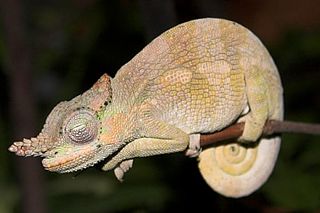
Kinyongia is a chameleon genus recently established for several plesiomorphic species found in forest and woodland in Kenya, Tanzania, Uganda, Rwanda, and far eastern DR Congo. All except K. adolfifriderici and K. tavetana are restricted to highlands, and many have very small geographic ranges. In most, at least the males have horns or knobs on their noses. They had been placed into the genus Bradypodion for some time. It has recently been pointed out that the ending to the specific epithet in several of the below listed species should be modified to match the feminine genus name.

Currently, two species are placed in the recently established genus Nadzikambia. They are plesiomorphic, small chameleons from the Ruo Gorge forest on Mount Mulanje in Malawi and Mount Mabu in Mozambique.
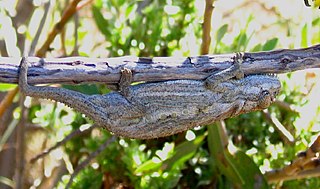
The Swartberg dwarf chameleon is a species of chameleon endemic to South Africa.

Kinyongia magomberae, commonly known as the Magombera chameleon, is a species of chameleon. The holotype of this species was discovered inside the jaws of a twig snake in the Magombera Forest of Tanzania by Andrew Marshall of the University of York. The snake was startled by Marshall and dropped the chameleon, which was examined and discovered to be a new species. Although this particular specimen did not survive, another one was found which did survive.
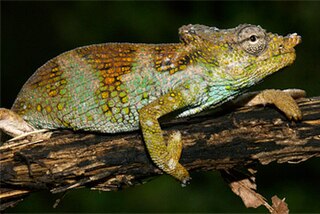
Kinyongia vanheygeni, the Poroto single-horned chameleon or Van Heygen's chameleon, is a species of chameleon, a lizard in the family Chamaeleonidae.
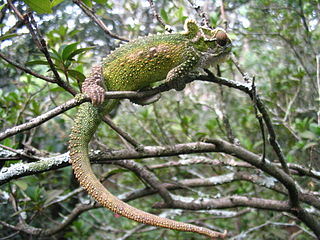
The Natal Midlands dwarf chameleon is a chameleon native to woodland habitat in the inland Midlands area of the South African province of KwaZulu-Natal.
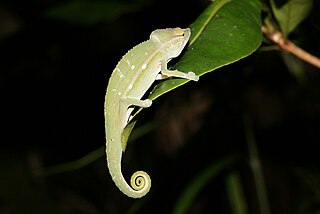
Chamaeleoninae is the nominotypical subfamily of chameleons. The Family Chamaeleonidae was divided into two subfamilies, Brookesiinae and Chamaeleoninae, by Klaver and Böhme in 1986. Since its erection in 1986, however, the validity of this subfamily designation has been the subject of much debate, although most phylogenetic studies support the notion that the pygmy chameleons of the subfamily Brookesiinae are not a monophyletic group. While some authorities have previously preferred to use the subfamilial classification on the basis of the absence of evidence principal, these authorities later abandoned this subfamilial division, no longer recognizing any subfamilies with the family Chamaeleonidae. In 2015, however, Glaw reworked the subfamilial division by placing only the genera Brookesia and Palleon within the Brookesiinae subfamily, with all other genera being placed in Chamaeleoninae.

The Mlanje Mountain chameleon is one of two species in the genus Nadzikambia. It is a plesiomorphic, small chameleon from the Ruo Gorge forest on Mount Mulanje in Malawi.
Kinyongia asheorum, also known commonly as the Mount Nyiro bearded chameleon, is a species of lizard in the family Chamaeleonidae. The species is endemic to Kenya. Only four specimens are known.

Kinyongia boehmei is species of chameleon, a lizard in the family Chamaeleonidae. The IUCN Red List gives two alternative English common names for this species: Taita blade-horned chameleon and Böhme's two-horned chameleon. The species is endemic to Kenya.

Kinyongia mulyai is a species of chameleons first described in 2015, endemic to the Nzawa forest regions of the south-eastern Democratic Republic of the Congo.

Kinyongia uthmoelleri, known commonly as the Hanang hornless chameleon, Müller's leaf chameleon, and Uthmöller's chameleon, is species of lizard in the family Chamaeleonidae. The species is endemic to Tanzania.

Kinyongia vosseleri, also known commonly as the Usambara two-horned chameleon and Vosseler's blade-horned chameleon, is an endangered species of lizard in the family Chamaeleonidae. The species is endemic to Tanzania.
Rhampholeon beraduccii, also known commonly as Beraducci's pygmy chameleon or the Mahenge pygmy chameleon, is a species of lizard in the family Chamaeleonidae. The species is endemic to Tanzania.
Trioceros chapini, also known commonly as Chapin's chameleon, the gray chameleon, and the grey chameleon, is a species of lizard in the family Chamaeleonidae. The species is native to Central Africa.

Trioceros ellioti, also known commonly as Elliot's chameleon, Elliot's groove-throated chameleon, and the montane side-striped chameleon, is a species of lizard in the family Chamaeleonidae. The species is indigenous to Africa.
Trioceros nyirit, the Mount Mtelo stump-nosed chameleon or Pokot chameleon, is a species of chameleon endemic to Kenya.
















